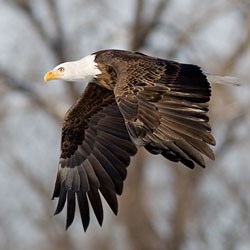
IntroductionThe bald eagle is the national bird of the United States and the only eagle that lives exclusively in North America. Golden eagles live in a broad swath across the northern hemisphere, including the United States. The bald eagle belongs to a larger group of eagle species called "sea eagles," because they are usually found near rivers or lakes, where they can feed on fish. They will also eat small mammals, such as rabbits, and will feed on carrion, such as deer killed by vehicles. It's often said that bald eagles mate for life, but this isn't completely true. While certain pairs remain together for many years, they will pair again if something happens to their mate. The pair may also winter in different areas and rejoin each other in early spring at their nesting site. Pair bonds may be partially or wholly dependent upon the quality of the territory. Bald eagles establish breeding territories from which they exclude other eagles. One or more nests may be found within a territory, but only one is used. The nest is added to each year before nesting. Adults may carry greenery and additional sticks to the nest even when chicks are present. Nests on average are four to six feet across and three feet deep. That's large enough to fit a person inside! Bald eagles are long-lived birds. Schempf reports a wild bald eagle living to 28 years of age and the Bird Banding Laboratory at Cornell University lists a record of a wild eagle living into its 30th year. Newton reported a captive eagle living to 36 years of age. Bald eagle populations declined in the 19th and 20th centuries due to shooting and egg collecting. Their numbers began to rebound once they received protection through laws such as the Bald Eagle Protection Act of 1940, the Lacey Act, the Endangered Species Act, and two migratory bird treaties. Just as their populations were recovering, the use of DDT, an insecticide that "bioaccummulates" in the food chain, caused egg shell thinning and bald eagle populations began to decline again. After the United States and Canada banned DDT in the early 1970s, eagle populations began to recover. Eagles in the ParkThe Mississippi National River and Recreation Area has a growing population of bald eagles. In 2015 there were 46 active bald eagle nests along the 72 mile stretch of river running through the Mississippi National River and Recreation Area. Bald eagles may be seen throughout the Park, even in downtown areas along the river. The Mississippi National River and Recreation Area and its partners conduct an annual eagle nest survey to better understand and mitigate the challenges faced by these birds. Identification
| |
Last updated: October 8, 2021
